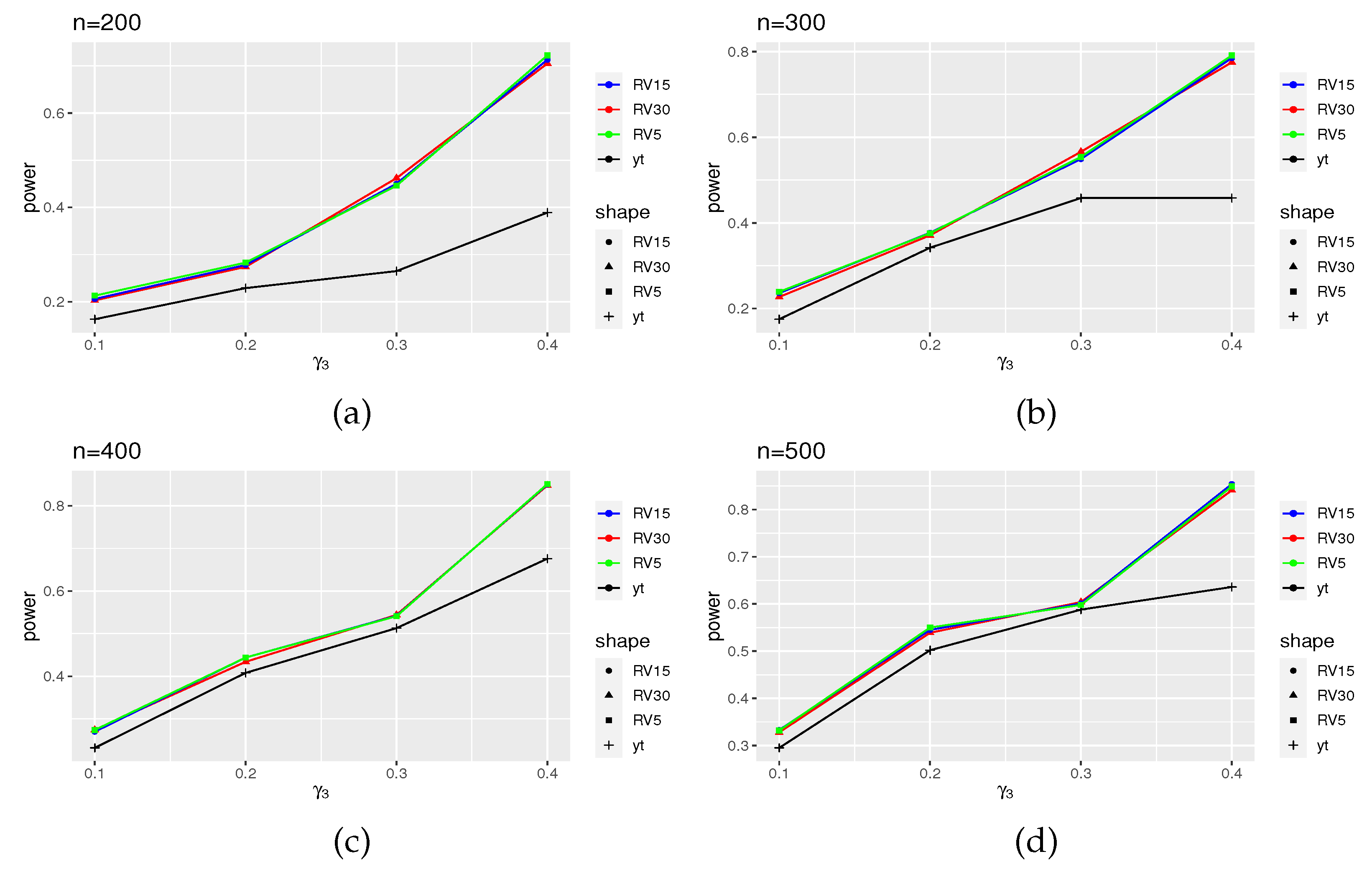Securities trading has always been a prominent topic in the financial sector, and volatility serves as a crucial indicator for analyzing fluctuations in trading price data. Volatility reflects the expected level of price instability in a financial asset or market, which greatly influences investment decisions [
1]. In the field of volatility modeling, the autoregressive conditional heteroscedasticity (ARCH) model and the generalized autoregressive conditional heteroscedasticity (GARCH) model are widely recognized as two fundamental models [
2]. Let
be the log-return of day
t. The ARCH model proposed by Engle (1982) [
3] is structured as follows:
where
is an independent and identically distributed (i.i.d.) sequence, and
represents the volatility of
. Additionally, it is assumed that the expectation of
is zero, i.e.,
, and the expectation of
is equal to one, i.e.,
. The parameters
are the coefficients associated with the lagged squared observations
, which need to be estimated. ARCH models are commonly employed in time-series modeling and analysis. However, when the order
q of the ARCH(
q) model is large, the number of parameters that require estimation increases. This can lead to challenges in estimation, particularly in cases with finite samples where estimation efficiency may decrease. Furthermore, it is possible for the estimated parameter values to turn out negative. To address these limitations, Bollerslev (1986) [
4] proposed the generalized autoregressive conditional heteroscedasticity (GARCH) model. For the pure GARCH(1,1) model, the conditional variance equation is expressed as follows:
Obviously, Formula (
1) is an iterative equation. Let
. Then
From (
1) and (
2), we obtain
Repeating the process above, we expand
. Then, we can obtain an infinite-order ARCH model. Since the GARCH model is a generalization of the ARCH model, they are collectively referred to as the ARCH-type models. In financial data analysis, apart from heteroscedasticity, there are other prominent characteristics, such as the leverage effect (Black, 1976) [
5]. To address this, Geweke (1986) [
6] introduced the asymmetric log-GARCH model, while Engle et al. (1993) [
7] introduced the asymmetric power GARCH model to account for the leverage effect. Furthermore, Drost and Klassen (1997) [
8] modified the pure GARCH(1,1) model as follows:
For the ARCH(q) case, the conditional variance equation is given by
When
,
, and
, the models (
3) and (
4) can be transformed into the pure GARCH(1,1) model. Similarly, the models (
3) and (
5) can be transformed into the pure ARCH(
q) model. The advantage of this model is that the standardization of
only affects the parameter
. By standardizing the residuals, they are made unit variance, simplifying the estimation process and allowing the focus to be on estimating the parameters of interest without being influenced by the scale of the residuals.
With the advancement of information technology, obtaining intraday high-frequency data has become effortless, and such data often contain valuable information. Recognizing this, Visser (2011) [
9] introduced high-frequency data into models (
3) and (
4), leading to improved efficiency in model parameters estimation. Subsequently, numerous researchers have extensively explored the enhancement of classical models by utilizing high-frequency data. Huang et al. (2015) [
10] incorporated high-frequency data into the GJR model (named by the proponents Glosten, Jagannathan and Runkel) [
11] and examined a range of robust M-estimators [
12]. Wang et al. (2017) [
13] employed composite quantile regression to examine the GARCH model using high-frequency data. Other notable studies include Fan et al. (2017) [
14], Deng et al. (2020) [
15], and Liang et al. (2021) [
16].
In addition to model parameter estimation, model testing plays a crucial role in time-series modeling and analysis as researchers seek to assess the adequacy of the established models. Portmanteau tests have been widely used for this purpose. The earliest work in this area can be traced back to Box and Pierce (1970) [
17], who demonstrated the utility of square-residual autocorrelations for model testing. Since then, several researchers have applied this test to time-series models, including Granger et al. (1978) [
18] and Mcleod and Li (1983) [
19]. For instance, Engle and Bollerslev (1986) [
20] and Pantula (1988) [
21] proposed the test to examine the presence of ARCH in the error term. However, Li and Mak (1994) [
22] showed that the variance of the residual autocorrelation function is not idempotent when using ARCH-type models. To overcome this issue, they developed a modified statistic that incorporated the variance of the residual autocorrelation function. They also proved that when the parameter estimates follow asymptotic normality, the test statistic follows a chi-square distribution. After the emergence of the quasi-maximum exponential likelihood estimation (QMELE) method [
23], Li and Li (2005) [
24] generalized the test statistic proposed by Li and Mak [
22] using a new estimation method. They also proposed a similar test statistic for the autocorrelation function with absolute residuals
. Carbon and Francq (2011) [
25] extended the test of Li and Mak [
22] to the asymmetric power GARCH model. Furthermore, Chen and Zhu (2015) [
26] constructed a rank-based portmanteau test based on Li and Mak’s [
22] statistic. They modified the autocorrelation function of the residuals
to the autocorrelation function of the rank-based residuals
, making the new test applicable to heavy-tailed data. Even today, scholars like Li and Zhang (2022) [
27] continue to show great interest in studying the extension of these tests.
















